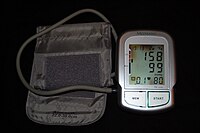
Photo from wikipedia
Renal artery (RA) stenosis is one of the main causes of severe uncontrolled primary hypertension among population. Aim of the study was to investigate effectiveness of stent replacement in renal… Click to show full abstract
Renal artery (RA) stenosis is one of the main causes of severe uncontrolled primary hypertension among population. Aim of the study was to investigate effectiveness of stent replacement in renal arteries and influence it on renal function in uncontrolled hypertensive patients (UHP) with pharmacotherapies. 86 consecutive UHP with renal etiology confirmed by angiography were enrolled in this study. Mean age of the patients was 43.2±12.5 years (aged 31–59 years, male=46%). Blood pressure, serum creatinine, microalbuminuria were assessed at baseline and after the intervention and during the follow-up for statistics. Mean follow-up was 2.0±1.0 years. Total of 128 hemodynamically significant renal artery stenosis were treated by implanting stents in all 86 patients. Among them in 42 patients were performed bilateral stenting (Group I) and 44 patients unilateral stenting (Group II). Systolic and diastolic blood pressure (SBP, DBP) decreased in both groups during the follow-up, however it was noted that only SBP were decreased significantly in Group I (unilateral stenting) whilst reduction in DBP not significantly when compared to Group II. Mean reduction in SBP was from 165.0±20.5 mmHg to 130.4±14.0 mmHg in Group I vs. from 158.0±22.0 to 135.0±15.0 mmHg in Group II (P=0.003 when compared two groups) and in DBP was from 95.0±11.2 mmHg to 83.4±8.0 mmHg in Group I vs. from 93.0±10.0 to 82.0±7.5 mmHg in Group II (P>0.05 when compared two groups). Serum creatinine levels were reduced from 123.0±49.0 μmol/l to 85.4±30.6 μmol/l in Group I vs 116.8±51.2 μmol/l to 86.9±35.5 μmol/l (P<0.05 when compared two groups). Significantly reduction in MAU were noted in both groups (P<0.05) but when compared two groups there were no significant changes in reduction. Renal artery stenting is effective method for the treatment of UHP and may improve outcomes of the patients. Bilateral stenting seems to be more effective in blood pressure and serum creatinine control in UHP.
Journal Title: European Heart Journal
Year Published: 2019
Link to full text (if available)
Share on Social Media: Sign Up to like & get
recommendations!